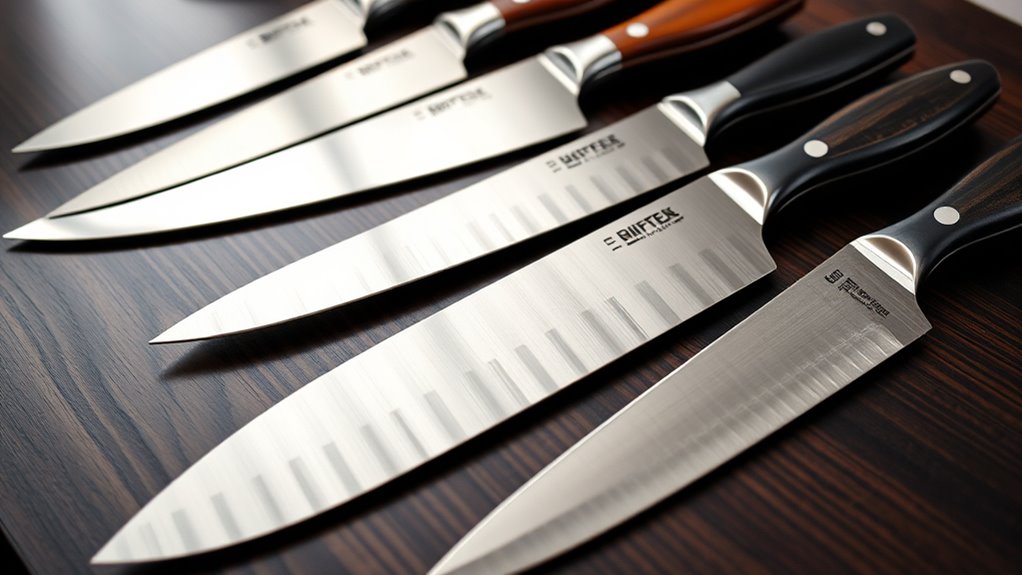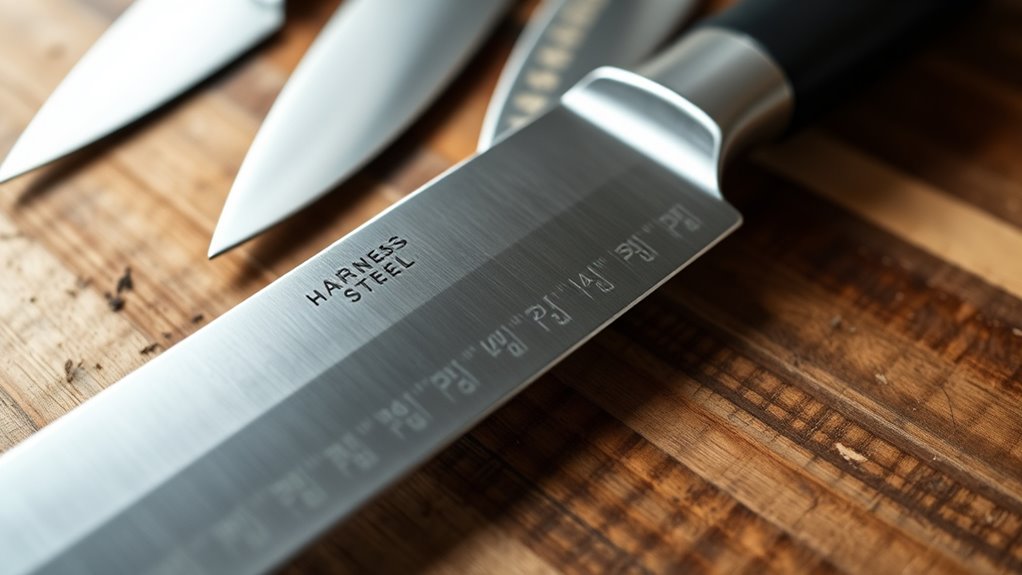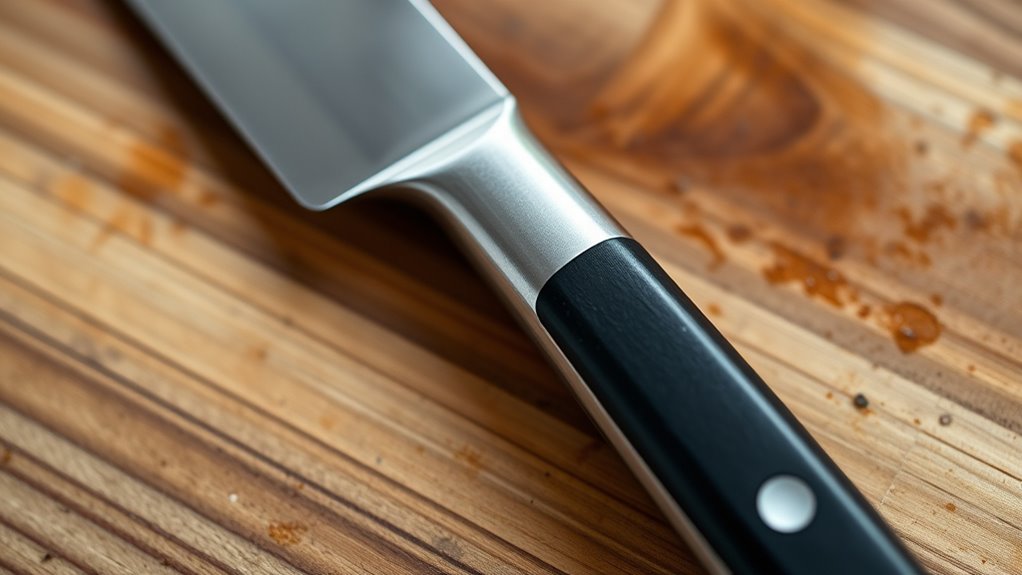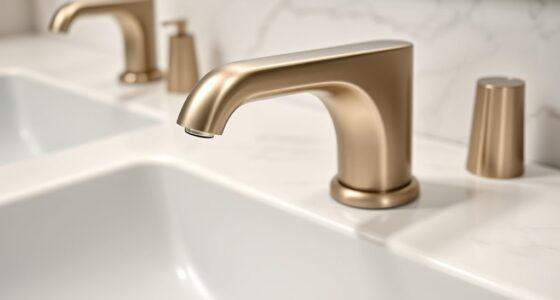Choosing the right kitchen knife isn’t just about style—it’s about matching the blade shape, material, and handle to your cooking needs. Focus on selecting a versatile all-rounder like a Gyuto or Nakiri, and consider the steel’s composition for sharpness and maintenance. Pay attention to handle comfort and balance, ensuring safety and ease of use. Avoid common mistakes by understanding these factors—keep going to discover how to pick the perfect knife for every task.
Key Takeaways
- Match the knife type and blade design to specific tasks and foods for optimal performance.
- Prioritize ergonomic handles with comfortable grip and proper balance to reduce fatigue during extended use.
- Choose high-quality steel with appropriate hardness (around 56-61 HRC) for durability, sharpness, and ease of maintenance.
- Consider the knife’s purpose—versatile all-rounders like Gyuto are ideal for everyday use, reducing clutter.
- Regularly sharpen and maintain your knives to prevent dullness, chipping, and ensure safe, precise cutting.
Understanding the Different Types of Kitchen Knives and Their Uses

To choose the right kitchen knife, you need to understand the different types and their specific uses. Kitchen knives vary in blade shape and length to suit various cutting tasks. For example, chef’s knives are versatile, great for chopping and slicing, while paring knives excel at detail work like peeling. Bread knives feature serrated blades that easily cut through crusty loaves without crushing the soft interior. Specialized knives like Nakiri or Usuba are designed for vegetables, with straight-edged blades for clean, precise cuts. The steel types used influence durability and sharpness, and handle ergonomics are essential for comfort during prolonged use. Effective knife selection depends on understanding these differences, ensuring you pick the right tool for each task, making your cooking safer and more efficient. Additionally, blade design plays a crucial role in how well a knife performs specific tasks, affecting both precision and ease of use.
Factors to Consider When Selecting a Knife: Blade Shape, Material, and Handle Comfort

When selecting a kitchen knife, paying attention to the blade shape, material, and handle comfort guarantees you choose a tool that works best for your needs. The blade shape should suit your primary tasks—wider blades excel at chopping vegetables, while narrower, longer blades are better for raw meat and fish. Material impacts sharpness, edge retention, and maintenance; high-carbon steels stay sharper longer but can patina, whereas stainless steels resist rust but may need more frequent sharpening. Handle comfort depends on fit, shape, and material, with ergonomic designs reducing fatigue and improving control. Testing handle feel and balance in person helps you find a shape that fits your grip style, ensuring safe, precise cuts while minimizing strain during extended use. Additionally, diverse designs in knife handles can enhance grip stability and overall comfort during prolonged cooking sessions. Incorporating a handle with ergonomic features can further reduce hand fatigue and improve precision. Considering handle designs that promote proper grip technique can also contribute to safer and more efficient cutting. Understanding blade material and its properties can help you select a knife that maintains sharpness longer and requires less frequent sharpening.
How Steel Composition Affects Performance and Maintenance

Your choice of steel affects how durable, sharp, and easy to maintain your knife will be. High-carbon steels hold an edge longer but may rust if not cared for properly, while stainless steels resist corrosion but might need more frequent sharpening. Understanding these differences helps you pick a steel that matches your cooking habits and maintenance preferences. Additionally, considering the for sale 100 availability of certain steel types can influence your decision depending on your budget and access.
Steel Types and Durability
Steel composition plays a crucial role in determining a kitchen knife’s performance and how much maintenance it requires. High-carbon steel, like Aogami or Shirogami, stays sharper longer but is more prone to rust and patina without proper care. Proper planning can help prevent damage and ensure longevity. Additionally, understanding the steel’s microstructure can guide you in selecting knives that balance sharpness and durability. The steel’s composition—especially the ratios of carbon, chromium, vanadium, and molybdenum—directly influences durability, sharpness, and ease of maintenance. Recognizing the microstructure’s impact on edge stability helps in choosing the right steel for specific culinary tasks. Cementite formation within steel microstructure can significantly affect the edge retention and corrosion resistance of your knife. Laminated Damascus steels combine a hard core with softer outer layers, balancing performance and rust resistance.
Edge Retention and Sharpness
The composition of a knife’s steel directly determines how well it retains its edge and how easily it can be sharpened. Steel hardness, measured by HRC ratings, influences edge retention—the harder the steel, the longer the sharpness lasts. High-carbon content and advanced carbides from elements like vanadium, molybdenum, and chromium enhance blade durability and wear resistance, making the edge hold longer. Additionally, steels with higher carbon and alloying elements tend to be more resistant to dulling but may demand extra effort to restore sharpness. Laminated blades balance hard cores for edge retention with softer outer layers, offering a practical mix of sharpness, durability, and ease of sharpening. Furthermore, understanding the steel composition can help you select a knife that aligns with your maintenance preferences and usage needs, especially when considering hardness levels for specific tasks. The heat treatment process also plays a crucial role in optimizing the balance between hardness and toughness, impacting how the blade performs over time.
Maintenance and Resharpening
Ever wondered how steel composition impacts the maintenance and sharpening of your kitchen knives? Your knife’s steel affects how easily it’s sharpened and how well it retains its edge. High carbon steels and alloys like V, Mo, and Cr offer excellent edge retention but may require specialized sharpening tools to prevent chipping. Hardened steels (58-64 HRC) keep a sharp edge longer but need careful honing and professional sharpening to avoid damage. Laminated Damascus blades combine a hard core with softer outer layers, making resharpening easier while boosting durability. Stainless steels with high chromium resist rust but often demand more frequent honing. Understanding different steel types can help you choose the right knife for your needs and maintenance preferences. Regular blade maintenance—honning and occasional professional sharpening—extends your knife’s lifespan, regardless of the steel type, keeping it performing at its best. Additionally, understanding how steel composition influences performance can help you invest in a knife that balances durability with ease of maintenance. Knowing how heat treatment affects steel hardness can also guide your care routine and sharpening techniques.
Choosing the Right Blade Hardness for Long-Term Durability

Choosing the right blade hardness means finding a balance between sharpness and toughness. Harder steels, around 64-67 HRC, stay sharp longer but can chip more easily, especially if mishandled. Steel composition and proper heat treatment play vital roles in achieving durability that lasts. Incorporating glycolic acid treatments in skincare routines demonstrates the importance of selecting formulations that match specific skin concerns, similar to choosing the appropriate hardness level for different knives. Additionally, understanding home cinema advancements can inspire new ways to appreciate sharp visuals and immersive experiences at home. Being aware of asset division strategies can also inform how one approaches the care and maintenance of valuable tools like knives to preserve their functionality over time. For enthusiasts, tuning methods like Volkswagen TDI Tuning highlight the significance of precise adjustments to optimize performance and longevity of their investments. Recognizing how suspension upgrades enhance handling can also help in selecting the right modifications for durability and improved control.
Balancing Sharpness and Toughness
Finding the right balance between sharpness and toughness hinges on selecting a blade with the appropriate hardness level. Steel hardness directly impacts edge retention, blade durability, and resistance to chipping. Steel around 56 HRC offers a good mix of sharpness and toughness, making it versatile for daily use. Harder steels, like 60-61 HRC, sharpen easily and hold edges longer but can be more brittle. Conversely, steels below 56 HRC dull quickly, requiring frequent resharpening. Here’s a quick comparison:
| Hardness (HRC) | Sharpness & Edge Retention | Toughness & Resistance to Chipping |
|---|---|---|
| <56 | Dulls fast, less durable | High |
| 56-61 | Balanced, long-lasting | Moderate |
| >64 | Excellent edge retention | More prone to chipping |
Choose based on your maintenance ability and kitchen needs.
Optimal Hardness Levels
Selecting the appropriate hardness level for your kitchen knife is essential for achieving long-term durability and reliable performance. Aim for a hardness of 56 HRC or higher to ensure good edge retention without sacrificing toughness. Steel with a high hardness, around 64-67 HRC, offers superior sharpness and edge retention but demands careful sharpening and maintenance. Softer steels, below 56 HRC, tend to dull faster and are harder to resharpen effectively. Stainless steels with high chromium and moderate carbon levels, around 56-60 HRC, strike a good balance between rust resistance and manageable sharpening. Keep in mind, blades with excessive hardness—above 67 HRC—can become brittle, increasing the risk of chipping or cracking during use, affecting overall temperament and longevity.
Steel Composition Impact
The steel composition of your kitchen knife directly impacts its long-term durability and performance. Higher carbon content (above 0.8%) allows for greater hardness and edge retention but can make the blade more brittle. Stainless steel with balanced alloying—especially high chromium—offers corrosion resistance without sacrificing hardness, ideal for everyday use. Different steel alloys provide varying blade durability and ease of sharpening, with powdered steels reaching 64-67 HRC for superior performance. Laminated steel combines a hard core with softer outer layers, enhancing durability and aesthetic appeal.
- Higher carbon content boosts hardness but can increase brittleness
- Stainless steels balance corrosion resistance and hardness
- Steel alloys influence blade durability and maintenance
- Hardness measured in HRC affects longevity
- Laminated blades optimize strength and aesthetics
Picking the Perfect Handle: Material, Shape, and Balance

Choosing the right handle for your kitchen knife is essential for both comfort and control. The handle’s material influences grip, with wood offering a natural feel and synthetic options providing durability and moisture resistance. Handle shape—such as round, D-shaped, or octagonal—affects comfort and control, with ergonomic designs like D-shapes suited for right-handed users. Proper balance between the handle and blade reduces fatigue and boosts precision, often achieved by the handle’s weight and material. Handle size should match your hand; smaller hands prefer thinner, contoured handles, while larger hands benefit from thicker grips. Secured with rivets or a full tang, handles offer stability and durability, creating a balanced, comfortable, and long-lasting tool for extended use.
Practical Tips for Testing and Evaluating Knives In-Person

When evaluating a knife in person, start by holding it comfortably in your hand and simulating common cutting motions. This helps you assess the handle fit, ensuring it feels secure without discomfort. Check the balance point by resting the blade on your finger at the handle; it should feel evenly balanced, not tipping forward or backward. Test the sharpness by slicing through a firm vegetable or paper; a sharp blade cuts smoothly with minimal effort. Pay attention to the weight and grip—your knife should feel natural and reduce fatigue during extended use.
- *Test handle fit for security and comfort*
- *Evaluate balance by resting on your finger*
- *Perform blade test for sharpness*
- *Assess weight for fatigue reduction*
- *Simulate cutting motions to check grip control*
Essential Knives for Every Kitchen and When to Expand Your Collection

A well-rounded kitchen starts with a few essential knives that can handle most tasks efficiently. An all-purpose knife like a Japanese Gyuto or Western chef’s knife, typically 8-10 inches, covers most cutting needs with its versatile blades. Pair it with a paring knife for detailed work and peeling, and a serrated bread or tomato knife for crusty bread and soft fruits. When expanding your collection, focus on high-quality steel—preferably 56 HRC or higher—and an ergonomic handle for durability and comfort. Consider your cooking style—vegetables, meats, or delicate tasks—to choose knives that boost efficiency and safety. Remember, a carefully selected set of 3-5 quality knives can meet the majority of your culinary needs without cluttering your kitchen.
Proper Care and Maintenance to Preserve Your Knives’ Sharpness and Longevity

Maintaining your knives’ sharpness and extending their lifespan requires consistent care and proper techniques. Regular honing with a steel realigns microscopic burrs, keeping the edge sharp between sharpenings. Hand washing knives immediately after use with gentle detergents prevents corrosion and preserves the steel’s integrity. Proper storage—like knife blocks, magnetic strips, or blade guards—protects the edge and prevents dulling or accidental damage. Avoid cutting on hard surfaces such as glass or ceramic, which can chip or dull the blade. Periodic professional sharpening ensures precise edge maintenance and prolongs your knife’s life. Taking these steps helps your knives stay sharp, functional, and safe to use for years to come.
- Use a steel regularly for edge maintenance
- Hand wash and dry immediately after use
- Store knives properly to prevent damage
- Avoid cutting on hard surfaces
- Schedule professional sharpening periodically
Common Mistakes Home Cooks Make When Choosing and Using Knives

Many home cooks make the mistake of choosing knives based solely on their appearance or price, rather than considering comfort, balance, and suitability for the task. This often results in poor control during prep work, leading to fatigue and potential accidents. Some select knives without paying attention to handle ergonomics, which can cause discomfort and reduce precision over time. Additionally, choosing a blade based only on steel type without considering blade hardness or intended use can cause dulling or difficulty in sharpening, increasing sharpening mistakes. Relying on a single versatile knife is better than overbuying specialty tools, which may go unused. Proper knife selection involves understanding these factors to ensure safety, efficiency, and longevity of your tools.
How to Match Your Knives to Your Specific Cooking Tasks

Choosing the right knife depends on the specific foods you’ll prepare, so match your blades accordingly. Prioritize handles that feel comfortable during extended use, and consider a versatile all-rounder for general tasks. This approach guarantees your knives are both effective and comfortable for every cooking task.
Match Knife to Food
Matching the right knife to the food you’re preparing is essential for efficient and safe cooking. The correct blade makes your cutting tasks easier and safer, whether you’re slicing vegetables or raw meat. For vegetables, use wider blades like Nakiri or Usuba to achieve precise, straight cuts. When working with raw meat, narrower, longer blades such as Yanagiba or Gyuto provide better control for slicing. For large cuts or tough tasks, heavy knives like cleavers are ideal, while smaller paring knives excel at peeling and trimming. Serrated knives work well for bread or tomatoes with tough exteriors. Remember, blade length influences knife control—shorter blades offer better maneuverability for detailed work, and larger blades are better for bigger foods. Match your knife to the food for ideal results.
- Use wider blades for vegetables to ensure straight cuts
- Choose narrow blades for slicing raw meat and fish
- Match heavy knives like cleavers to tough or large cuts
- Pick small, pointed knives for peeling and detailed tasks
- Select serrated knives for bread and tomatoes
Prioritize Handle Comfort
A handle that fits comfortably in your hand is essential for safe and efficient cooking, especially during extended tasks. An ergonomic handle with the right shape, size, and material ensures grip comfort and reduces fatigue. Test handles in person to find one that feels snug without causing strain. Handles with natural wood or synthetic materials influence grip texture and moisture resistance, affecting control. Proper handle design, like D-shaped or oval profiles, accommodates different hand sizes and grip styles. Additionally, a well-balanced knife with a handle that complements the blade minimizes wrist fatigue.
| Handle Material | Grip Comfort |
|---|---|
| Natural wood | Moisture resistance |
| Resin | Texture feel |
| Metal | Durability |
Use Versatile All-Rounder
Selecting the right all-rounder knife guarantees you’re prepared for a variety of kitchen tasks without cluttering your drawer. A versatile knife like a 210mm Gyuto or Bunka handles everything from slicing vegetables to cutting meat, reducing the need for multiple tools. Look for a multi-purpose blade with balanced weight and a comfortable handle to ensure control and minimize fatigue. High-quality steel, such as VG-10 or powdered steels with 60+ HRC, maintains sharpness longer and resists dulling from daily use. When testing knives in person, focus on handle ergonomics and overall feel to find one that fits comfortably in your hand. An all-rounder simplifies your collection—use it well, and expand only if specific tasks require specialized knives.
- Versatile, all-rounder blades handle many tasks
- Sharpness is maintained longer with quality steel
- Balance and handle comfort aid control
- Reduced clutter by focusing on a single knife
- High-quality steel resists dulling over time
Frequently Asked Questions
How to Choose the Right Kitchen Knife?
When choosing a kitchen knife, you need to consider your main cooking tasks and pick a versatile Gyuto, precise Paring, or heavy-duty Cleaver accordingly. Test handle comfort and balance in your hand to ensure control. Also, select high-quality steel with a hardness of 56 HRC or more for durability. Match blade width and length to your typical ingredients, and look for layered steel for sharpness retention and easier sharpening.
What Is the Rule #1 in Knife Skills?
Think of your knife as a trusted dance partner. Rule #1 is to grip it firmly, like holding your partner securely, with your fingers wrapped around the handle and your thumb resting lightly. This control keeps your movements smooth and safe. Keep your fingers curled inward, forming a claw to shield them, and use a gentle rocking motion. Mastering this rhythm makes your cutting precise and injury-free.
What Is the Golden Rule for Knives?
The golden rule for knives is to focus on how it feels in your hand. You should prioritize handle comfort, balance, and ergonomics over its appearance. Test different knives in person to find one with a proper fit and weight distribution, ensuring safe, precise cuts. Remember, sharpness and blade thinness matter more than steel type. Choose a versatile knife suited to your needs and maintain it well for lasting performance.
What Are the 3 Basic Knives You Need in a Kitchen?
You need three basic knives in your kitchen. First, a versatile 8-10 inch chef’s knife handles most tasks like slicing and chopping. Second, a 3-4 inch paring knife is perfect for peeling and detailed work. Finally, an 8-10 inch serrated bread knife cuts through bread and soft produce without squishing. These three cover your essential prep needs, keeping your collection simple and effective.
Conclusion
Choosing the right kitchen knife can transform your cooking from good to legendary. By understanding the different types, materials, and how to care for them, you’ll wield your knives like a master swordsman. Avoid common pitfalls and match your blades to your tasks, and your kitchen will become a battlefield where you’re unstoppable. With the right tools, you’ll carve through prep like a hot knife through butter—making every meal an epic masterpiece.









